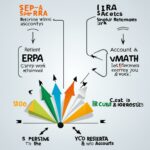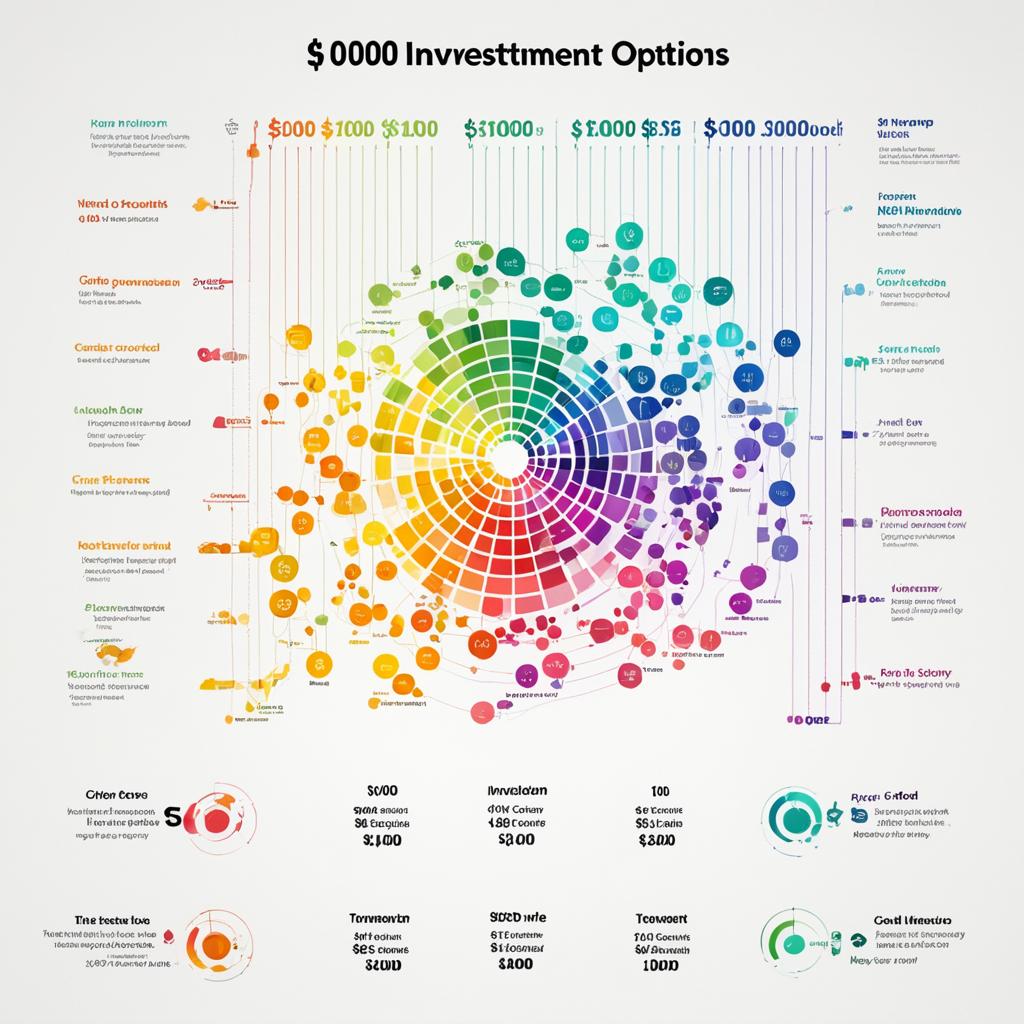If you have $1,000 saved and you’re looking to invest it, there are several options available to you. In this article, I will explore the 10 best ways to invest $1000 right now, ranging from building an emergency fund to investing in stocks. These strategies are beginner-friendly and offer potential for maximum returns on your investment.
Key Takeaways:
- Investing $1000 can be done in various ways, tailored to your financial goals and risk tolerance.
- Consider building an emergency fund to provide a safety net for unexpected expenses.
- Paying down debt, especially high-interest credit card debt, can free up financial resources and improve your situation.
- Retirement plans, such as 401(k) or IRA accounts, offer long-term benefits and can help grow your money.
- Options like certificates of deposit (CDs) and money market funds provide low-risk investment opportunities with guaranteed returns.
Build an emergency fund
One of the best ways to invest $1000 is to build an emergency fund. Having an emergency fund is crucial to your financial health as it provides a safety net for unexpected expenses such as job loss or medical bills.
Experts recommend having between three and six months’ worth of living expenses in your emergency fund. This allows you to weather any financial storms that may come your way without having to rely on credit cards or other forms of debt.
A good place to park your emergency fund is a high-yield savings account. These accounts offer higher interest rates than traditional savings accounts, allowing your money to grow over time. Look for FDIC-insured accounts for added safety and peace of mind.
With the power of compound interest, your emergency fund can continue to grow even when you’re not actively contributing to it. This means that over time, your $1000 investment can become an even larger sum that can support you during tough times.
Having an emergency fund is like having an insurance policy for your finances. It ensures that you have a cushion to fall back on when unexpected expenses arise.”
Benefits of a high-yield savings account
- Guaranteed returns: A high-yield savings account offers guaranteed returns in the form of compound interest, allowing your money to grow over time.
- Easy access to funds: Unlike long-term investments, a savings account offers easy access to your funds whenever you need them.
- FDIC-insured: Look for FDIC-insured accounts to ensure your money is protected up to $250,000 in the event of a bank failure.
By building an emergency fund through a high-yield savings account, you can invest your $1000 in a safe and accessible way while still earning a competitive interest rate. This not only helps protect your financial well-being but also provides peace of mind knowing that you’re prepared for the unexpected.
Pay Down Debt
If you have credit card debt, it’s crucial to prioritize paying it down when considering how to invest your $1000. Credit card debt can be a heavy burden, especially in a high-rate environment, and the interest charges can eat into your finances. In fact, the interest you pay on your debt is often much higher than any potential investment returns you could earn.
By using your $1000 to make a one-time payment towards your debt, you can save money on interest charges and take a significant step towards improving your financial situation. Another option to consider is taking advantage of 0% intro APR credit cards, which offer a promotional period of 0% interest on balance transfers or purchases. This can provide temporary relief from high interest charges and give you time to pay down your debt more effectively.
Additionally, you may explore the option of a debt consolidation loan. This involves taking out a new loan to pay off multiple existing debts, combining them into one monthly payment with a potentially lower interest rate. This approach can simplify your debt management and potentially save you money on interest charges.
The Benefits of Paying Down Debt
When you pay down your debt, you enjoy several advantages:
- Reduced interest charges: By paying off your debt, you avoid accumulating unnecessary interest charges and free up funds for other purposes.
- Improved financial stability: Paying down your debt helps improve your overall financial situation, giving you peace of mind and reducing financial stress.
- Better credit score: Lowering your credit utilization by paying down debt can positively impact your credit score, making it easier to secure loans or credit in the future.
- Future financial flexibility: By eliminating debt, you have the opportunity to redirect the money you were spending on interest towards saving, investing, or achieving other financial goals.
Remember, paying down debt should be a priority before considering other investment options. It’s a wise financial move that sets the foundation for long-term financial success.
| Option | Pros | Cons |
|---|---|---|
| Make a one-time payment towards debt | – Immediate reduction in debt – Saves on interest charges |
– Requires discipline to avoid accumulating more debt – May not eliminate debt entirely |
| 0% intro APR credit card | – Temporarily avoids interest charges – Provides time to pay down debt |
– Promotional period may expire quickly – Potential for high interest rates after promotional period |
| Debt consolidation loan | – Simplifies debt management – Potentially lowers overall interest rate |
– May require collateral or impose fees – Can prolong the debt repayment period |
Put it in a retirement plan
When deciding how to invest $1000, putting it into a retirement plan is a smart move. Retirement plans offer long-term financial security and growth potential. There are two primary options: employer-sponsored retirement plans and individual retirement accounts (IRAs).
Employer-Sponsored Retirement Plan
If your employer offers a retirement plan, such as a 401(k), 403(b), or 457 plan, make sure to take advantage of it. These plans often come with a valuable perk known as a 401(k) match. This means that for every dollar you contribute, your employer will match a percentage of it, up to a certain amount. It’s essentially free money!
Contributing to a retirement plan also has tax advantages. The money you contribute is typically tax-deductible, meaning it reduces your taxable income for the year. Additionally, the investment growth in your retirement account is tax-deferred until you withdraw the funds during retirement.
Individual Retirement Account (IRA)
If you don’t have access to an employer-sponsored retirement plan or want additional retirement savings, consider opening an individual retirement account (IRA). IRAs offer similar tax advantages and a wide range of investment options.
There are two main types of IRAs: traditional IRAs and Roth IRAs. With a traditional IRA, your contributions may be tax-deductible, and you’ll pay taxes when you withdraw the funds in retirement. With a Roth IRA, your contributions are made with after-tax dollars, but your withdrawals in retirement are tax-free.
Some popular IRA providers include Charles Schwab IRA and Fidelity Investments IRA. These providers offer competitive fees, a user-friendly platform, and a variety of investment choices to suit your retirement goals.
| Retirement Plan Option | Key Features |
|---|---|
| Employer-Sponsored Retirement Plan (e.g., 401(k)) |
|
| Individual Retirement Account (IRA) |
|
Open a Certificate of Deposit (CD)
When it comes to investing your $1000, opening a Certificate of Deposit (CD) is a solid option. CDs offer a fixed interest rate for a specific period, allowing you to earn predictable returns on your investment. The longer the term of the CD, the higher the Annual Percentage Yield (APY), giving you the opportunity to maximize your earnings.

CDs are known for their low-risk nature, making them a popular choice among conservative investors. When you open a CD, you agree to leave your money in the account for the duration of the term, which can range from a few months to several years. This fixed time commitment provides stability, ensuring that your investment is secure and protected.
While CDs offer attractive interest rates and stability, it’s important to be aware of the early withdrawal penalty. If you need to access your funds before the end of the term, you may incur a penalty fee. Therefore, it’s essential to carefully consider your financial goals and time horizon before investing in a CD.
When choosing a financial institution for your CD, consider reputable options like Synchrony Bank, Capital Funding Group, or Ally Bank. These institutions offer competitive interest rates and favorable terms, providing you with the opportunity to grow your investment effectively.
Benefits of Opening a Certificate of Deposit (CD)
Investing in a CD comes with several benefits that make it an attractive option for your $1000:
- Stable and predictable returns: With a fixed interest rate, you can calculate and anticipate the returns on your investment.
- Low-risk investment: CDs are considered low-risk as they offer guaranteed interest and principal protection.
- Diverse term options: Choose a term that aligns with your investment goals, whether short-term or long-term.
- Flexibility in interest payment: Some CDs offer the option to choose how you receive the interest earned, whether it’s reinvested or paid out regularly.
Comparing CD Rates and Terms
When selecting a CD, it’s crucial to compare rates and terms to make an informed decision. Here’s an overview of the rates and terms offered by Synchrony Bank, Capital Funding Group, and Ally Bank:
| Financial Institution | Interest Rate | Term |
|---|---|---|
| Synchrony Bank | 0.85% | 12 months |
| Capital Funding Group | 1.00% | 24 months |
| Ally Bank | 0.60% | 6 months |
Please note that rates and terms are subject to change and may vary based on market conditions. It’s essential to check the latest rates and terms offered by each institution before making a decision.
“A certificate of deposit can be a great option to earn stable returns on your $1000 investment while minimizing risk. Just remember to choose a term that aligns with your financial goals and carefully consider early withdrawal penalties.” – Me
Invest in Money Market Funds
When it comes to investing $1000, money market funds can be an excellent option for those seeking low-risk investments. Money market funds invest in lower-risk debt securities such as U.S. Treasury bills and commercial paper, making them some of the safest investments available. These funds offer the potential for stable returns while safeguarding your capital.
With money market funds, you can enjoy the benefit of easy access to your invested money. Whether you need to withdraw funds for an emergency or other financial needs, these investments offer the flexibility you desire. Additionally, money market funds typically provide monthly dividends, allowing you to gradually grow your investment.
Consider investing in money market funds through reputable institutions like Fidelity Investments or Vanguard. These companies have a long-standing reputation for providing reliable investment products and exceptional customer service.
| Attributes | Money Market Funds |
|---|---|
| Investment Type | Lower-risk debt securities |
| Risk Level | Low |
| Investment Returns | Stable |
| Dividends | Monthly |
| Access to Funds | Easy |
By investing in money market funds, you can enjoy the benefits of low-risk, reliable investments while having easy access to your money. Consider these funds as part of your investment strategy, allowing you to balance risk and returns while building your financial future.
Start (or add to) a savings account
If you don’t have an emergency fund or want to add to your existing savings, starting or adding to a savings account is a great way to invest $1000. A savings account provides a buffer for unexpected expenses and keeps you from resorting to high-interest borrowing.

One option is to open a traditional savings account at a reputable bank. This allows you to keep your cash on the sidelines, easily accessible whenever you need it. Savings accounts typically offer a modest interest rate, allowing your money to grow over time. Plus, your funds are FDIC-insured, providing an added layer of security.
If you’re looking for higher returns, you might consider a certificate of deposit (CD). CDs are time-based deposits that offer a fixed interest rate for a specified period. They generally provide higher interest rates compared to regular savings accounts, making them a suitable option for longer-term savings goals. However, keep in mind that CDs often carry early withdrawal penalties if you need to access your money before the CD matures.
Another alternative for growing your savings is Series I savings bonds. These bonds are issued by the U.S. Department of the Treasury and offer a low-risk investment option. Series I savings bonds accrue interest based on a combination of a fixed rate and an inflation rate, providing a level of protection against inflation.
| Type of Account | Minimum Deposit | Interest Rate | Accessibility | Additional Information |
|---|---|---|---|---|
| Traditional Savings Account | No minimum deposit | Varies by bank | Easy access | Funds are FDIC-insured |
| Certificate of Deposit (CD) | Varies by bank | Higher than savings account | Withdrawal penalties may apply | Fixed interest rate |
| Series I Savings Bonds | $25 minimum | Combination of fixed rate + inflation rate | Cannot redeem within the first year | Low-risk investment option |
Deciding between a savings account, CD, or Series I savings bonds depends on your financial goals and timeline. If you’ll need immediate access to your funds, a savings account might be the best choice. However, if you’re saving for a specific long-term goal and don’t mind a temporary lock-in period, a CD or Series I savings bonds could provide higher interest rates and potential growth.
Whatever you decide, starting or adding to a savings account is a prudent financial move that sets you up for future financial security.
Invest in a 401(k)
If you’re looking to make the most of your $1000 investment, consider investing in a 401(k) if your employer offers one. A 401(k) is a popular retirement plan that allows you to save for the future while enjoying potential tax advantages and employer contributions. By contributing to your 401(k), you not only save for retirement but also take advantage of the free money your employer offers through matching contributions.
In a 401(k), your contributions are deducted from your paycheck before taxes, which can lower your taxable income and potentially reduce your tax liability. This means you can save for retirement while enjoying immediate tax advantages.
One of the biggest advantages of a 401(k) is employer matching contributions. Many employers offer a matching program, where they contribute a certain percentage of your contribution, typically up to a certain percentage of your salary. This is essentially free money that can significantly boost your retirement savings.
To take advantage of your employer’s 401(k) program, reach out to your HR department or benefits representative for more information. They can provide you with details on how to enroll and take advantage of the employer match.
“Contributing to your 401(k) not only saves for retirement, but also takes advantage of employer contributions.”
Example Table: 401(k) Contribution Comparison
| Employee Contributions | Employer Match | Total Contributions |
|---|---|---|
| $500 | $500 (100% match) | $1000 |
| $700 | $350 (50% match) | $1050 |
| $1000 | $0 (No match) | $1000 |
The table above illustrates the potential impact of employer matching contributions on your total contributions. As you can see, by maximizing your employee contributions and taking advantage of the employer match, you can significantly increase your total contributions to the 401(k) plan. It’s important to note that the specific match percentage and contribution limits may vary depending on your employer’s plan.
By investing your $1000 in a 401(k), you not only benefit from potential tax advantages but also maximize your retirement savings through employer matching contributions. It’s a win-win situation that can set you on the path to a secure financial future.
Invest in an Individual Retirement Account (IRA)
When it comes to investing $1000, an Individual Retirement Account (IRA) can be a smart choice. Whether you don’t have access to an employer-sponsored retirement plan or simply want to supplement your existing retirement savings, an IRA provides flexibility and potential tax advantages. There are two main types of IRAs to consider: the traditional IRA and the Roth IRA.
Traditional IRA
If you choose a traditional IRA, your contributions may be tax-deductible, meaning you can potentially reduce your taxable income for the year. The earnings on your investments grow tax-deferred until you start making withdrawals in retirement. At that point, the withdrawals are subject to income tax. This type of IRA is an excellent option if you expect your tax rate to be lower in retirement than it is currently.
Roth IRA
A Roth IRA, on the other hand, offers tax-free withdrawals in retirement. While your contributions to a Roth IRA are not tax-deductible, the earnings on your investments grow tax-free. This can be a huge advantage if you anticipate being in a higher tax bracket during retirement. Additionally, a Roth IRA allows you to withdraw your contributions penalty-free at any time, making it a flexible choice.
When selecting an IRA, it’s important to choose a reputable online brokerage that offers these accounts. Two popular options are Charles Schwab and Fidelity Investments, both of which provide user-friendly platforms and a wide range of investment options.
It’s worth noting that there are eligibility requirements and annual contribution limits for IRAs. Make sure to review the current guidelines to ensure you can take full advantage of these accounts.
| IRA Type | Contributions | Tax Treatment | Withdrawals |
|---|---|---|---|
| Traditional IRA | Tax-deductible, up to annual limit | Tax-deferred growth | Taxable, subject to income tax |
| Roth IRA | Not tax-deductible | Tax-free growth | Tax-free, qualified withdrawals |
Investing in an IRA provides an opportunity to grow your retirement savings while taking advantage of potential tax benefits. Consider your financial goals and consult with a financial advisor to determine which type of IRA best fits your needs and long-term plans.

Open a Taxable Brokerage Account
If you’ve exhausted other options and still have $1000 to invest, opening a taxable brokerage account can be a good choice. This account allows you to invest in a variety of investment vehicles, such as low-cost mutual funds or individual stocks. While the earnings in a taxable brokerage account are taxable, the potential for higher returns makes it worth considering. Set up recurring deposits to continue building your investment portfolio.
Invest in ETFs
When it comes to investing $1000, exchange-traded funds (ETFs) are an excellent option for beginners like me. ETFs track various market indexes, providing instant diversification for my investment portfolio. Unlike actively managed mutual funds, ETFs offer benchmark tracking and come with lower fees.
One of the key advantages of investing in ETFs is the ability to start with small deposits. This makes it accessible to investors who are just getting started with a limited budget. To get started, I recommend looking for reliable online brokerages that offer a wide range of ETF options.
By investing in ETFs, I can benefit from the overall performance of the market. Whether it’s the stock market, bond market, or sector-specific indexes, there are ETFs available to match my investment goals and risk tolerance.
ETFs provide a passive investment strategy that allows me to build a well-rounded portfolio without the need for extensive research and frequent trading. The low fees associated with ETFs also help to minimize my investment costs, allowing me to maximize my potential returns.
Whether I’m looking to invest in broad-based indexes or specific sectors, ETFs provide the flexibility and convenience I need. With just $1000, I can start my journey to long-term wealth accumulation.
Use a Robo-Advisor
For those who prefer a hands-off approach to investing, using a robo-advisor is a smart option with $1000. A robo-advisor automates your investment portfolio management based on your financial goals and risk tolerance.
With a robo-advisor, you don’t need to spend time researching and analyzing individual investments. The platform uses algorithms to create a diversified portfolio tailored to your needs. It takes into account important factors such as your time horizon, risk tolerance, and financial goals, ensuring that your investments align with your long-term objectives.
Look for robo-advisors that offer low management fees to maximize your returns. These platforms often charge lower fees compared to traditional financial advisors, making them an affordable option for smaller investments like $1000.
In addition, some robo-advisors allow you to set up recurring deposits. This feature enables you to contribute regularly to your investment portfolio, helping you stay disciplined and build wealth over time.
If you’re new to investing or simply prefer a simplified approach, a robo-advisor can provide you with a convenient and efficient way to grow your money.

Benefits of Using a Robo-Advisor:
- Automated investment management tailored to your financial goals
- Low management fees, maximizing your investment returns
- Hands-off approach, saving you time and effort
- Diversified portfolio to minimize risk
- Recurring deposits for consistent contribution to your investments
Invest in Stocks
When it comes to investing $1000, one option that can potentially lead to high returns is investing in individual stocks. With fractional shares, you can own a portion of stocks from companies you believe in, even with a smaller investment amount. This allows you to have an ownership stake in these companies without having to spend a significant amount of money.
However, it’s important to approach stock investing with a long-term perspective. Instead of trying to time the market or chase short-term gains, focus on researching and choosing quality businesses with strong fundamentals. Look for companies that have a sustainable competitive advantage and a track record of success.
Once you have identified the stocks you want to invest in, consider holding them for a longer period of time, preferably for at least a few years. Long-term investment in stocks has the potential for significant growth and can help you ride out short-term market volatility.
One notable example of the benefits of long-term stock investing is Warren Buffett. Known as one of the most successful investors of all time, Buffett’s investment strategy revolves around buying stocks of solid companies and holding them for the long haul. His approach emphasizes the importance of patient investing and focusing on the underlying value of businesses.
“Buy into a company because you want to own it, not because you want the stock to go up.”
By following Buffett’s lead and adopting a long-term mindset, you can potentially build wealth through individual stock investments. However, it’s crucial to conduct thorough research and diversify your portfolio to mitigate risk.
Benefits of Individual Stock Investing
Investing in individual stocks offers several advantages:
- Potential for high returns: If you choose the right stocks, the returns can surpass those of other investment options.
- Ownership stake: Owning individual stocks allows you to become a shareholder and have a voice in the company’s decision-making process.
- Flexibility and control: With individual stocks, you have the freedom to make decisions based on your own research and investment strategy.
Considerations for Individual Stock Investing
Before investing in individual stocks, it’s important to keep the following in mind:
- Do thorough research: Analyze the company’s financials, competitive position, industry trends, and management team to make informed investment decisions.
- Diversify your portfolio: Investing in a mix of stocks from different sectors can help spread the risk and protect against market volatility.
- Stay updated: Regularly monitor your stocks and stay informed about any changes in the company or industry that may impact your investment.
Remember, investing in individual stocks can be a rewarding long-term investment strategy, but it requires careful selection, patience, and a commitment to continuous learning.
Conclusion
When it comes to investing $1000, there are a variety of options available to suit different financial goals, risk tolerance levels, and time horizons. By considering these 10 best ways to invest $1000 right now, you can make informed decisions and potentially achieve maximum returns on your investment.
Beginner-friendly options such as building an emergency fund or paying down high-interest debt provide a solid foundation for financial stability. Investing in retirement plans like a 401(k) or an individual retirement account (IRA) allows you to take advantage of employer matches or tax advantages.
For those seeking potentially higher returns, exploring options like stocks, ETFs, and taxable brokerage accounts can offer opportunities for growth. Remember to start small, educate yourself about investing, and diversify your portfolio to minimize risk.
Ultimately, the key to successful investing with $1000 lies in aligning your investment strategies with your financial goals and remaining committed to a long-term perspective. By making smart choices and staying informed, you can maximize your financial potential and set yourself on a path towards financial success.
FAQ
What is the best way to invest 00 right now?
The best way to invest 00 depends on your financial goals and risk tolerance. Some options include building an emergency fund, paying down debt, investing in retirement plans like a 401(k) or an IRA, opening a certificate of deposit (CD), investing in money market funds, starting or adding to a savings account, investing in ETFs or individual stocks, using a robo-advisor, or opening a taxable brokerage account. Consider your financial situation and long-term objectives before deciding.
How can I build an emergency fund with 00?
Building an emergency fund with 00 is a smart way to invest. You can open a high-yield savings account and put the 00 into it. Look for FDIC-insured accounts to ensure your money is safe. Over time, continue adding to your emergency fund until you have three to six months’ worth of living expenses saved.
Is it better to pay down debt or invest my 00?
If you have high-interest debt, it is generally better to pay it down before considering investing. High-interest debt can weigh you down financially, and the interest charges are typically higher than any potential investment returns. By paying off your debt, you can save money on interest charges and improve your overall financial situation.
Should I invest my 00 in a retirement plan?
Investing 00 in a retirement plan is a wise decision for your long-term financial health. If your employer offers a 401(k) match, take advantage of this benefit as it’s essentially free money. If you don’t have an employer-sponsored retirement plan, consider opening an individual retirement account (IRA) with a reputable online brokerage like Charles Schwab or Fidelity Investments.
What’s a certificate of deposit (CD) and should I invest my 00 in one?
A certificate of deposit (CD) is a low-risk investment option that offers a fixed interest rate for a specific period of time. While CDs generally have early withdrawal penalties, they can be a safe way to grow your money. Consider opening a CD with institutions like Synchrony Bank, Capital Funding Group, or Ally Bank that offer competitive interest rates and terms.
Are money market funds a good investment option for my 00?
Money market funds can be a smart investment option for those seeking lower-risk investments. These funds invest in lower-risk debt securities like U.S. Treasury bills and commercial paper, making them safer than other investment options. Money market funds offer monthly dividends and easy access to your invested money. Consider investing through reputable institutions like Fidelity Investments or Vanguard.
Should I start or add to a savings account with my 00?
Yes, starting or adding to a savings account is a great way to invest 00. A savings account provides a buffer for unexpected expenses and prevents you from resorting to high-interest borrowing. You can also explore options like CDs or Series I savings bonds to boost your savings with higher interest rates.
Is it a good idea to invest my 00 in a 401(k) if my employer offers one?
Investing in a 401(k) offered by your employer is a smart way to make use of your 00. By contributing to your 401(k), you not only save for retirement but also receive free money through employer matching contributions. Consider increasing your contribution temporarily to utilize your 00 investment and then revert back to your regular contribution level.
Should I invest my 00 in an IRA?
Investing in an individual retirement account (IRA) can be a viable option if you don’t have access to an employer-sponsored retirement plan. With a traditional IRA, your contributions may be tax-deductible, while a Roth IRA offers tax-free withdrawals in retirement. Look for online brokerages that offer IRA accounts, such as Charles Schwab and Fidelity Investments, and consider your eligibility and contribution limits.
Is opening a taxable brokerage account a good way to invest my 00?
If you have exhausted other options and still have 00 to invest, opening a taxable brokerage account can be a good choice. This account allows you to invest in a variety of investment vehicles, such as low-cost mutual funds or individual stocks. While the earnings in a taxable brokerage account are taxable, the potential for higher returns makes it worth considering. Set up recurring deposits to continue building your investment portfolio.
Should I consider investing in ETFs with my 00?
Investing in exchange-traded funds (ETFs) is a beginner-friendly way to invest 00. ETFs track various market indexes and offer diversification at a lower cost compared to actively managed mutual funds. Look for online brokerages that offer a wide range of ETFs and allow small deposits. By investing in ETFs, you can build a well-rounded portfolio and benefit from the overall performance of the market.
Is using a robo-advisor a good option for investing my 00?
Using a robo-advisor can be a smart option for those who prefer a hands-off approach to investing. A robo-advisor automates your investment portfolio management based on your financial goals and risk tolerance. Look for robo-advisors with low management fees and the ability to set up recurring deposits. This approach simplifies investing and ensures that your money is being managed according to your long-term goals.
Should I invest my 00 in individual stocks?
Investing in individual stocks can be a rewarding way to invest your 00. With fractional shares, you can own a portion of stocks from companies you believe in without spending a significant amount of money. When investing in stocks, it’s important to research and choose quality businesses with a long-term perspective. Consider holding the stocks for at least a few years to maximize the potential for growth.
What are the best ways to invest 00 right now?
The best ways to invest 00 right now include building an emergency fund, paying down debt, investing in retirement plans like a 401(k) or an IRA, opening a certificate of deposit (CD), investing in money market funds, starting or adding to a savings account, investing in ETFs or individual stocks, using a robo-advisor, or opening a taxable brokerage account. Consider your financial goals, risk tolerance, and time horizon before making a decision.
Our Friends
- https://www.moneyunder30.com/10-ways-to-invest-1000/
- https://www.fool.com/investing/how-to-invest/how-to-invest-1000-dollars/
- https://www.cnbc.com/select/best-ways-to-invest-1000/
Money posts:
 9 Best Investments for a Roth IRA (2024)
9 Best Investments for a Roth IRA (2024)
 Roth vs. Traditional IRAs (2024)
Roth vs. Traditional IRAs (2024)
 SEP IRA vs Simple IRA – What’s the Difference & Which is Best for You in 2024
SEP IRA vs Simple IRA – What’s the Difference & Which is Best for You in 2024
 SEP IRA Contribution Limits for 2024 and 2024
SEP IRA Contribution Limits for 2024 and 2024
 Retirement Financial Advisor: Types + Responsibilities (2024)
Retirement Financial Advisor: Types + Responsibilities (2024)
 Will Millennials Be Able to Retire? (2024)
Will Millennials Be Able to Retire? (2024)
 7 Best Investments for Taxable Accounts (2024)
7 Best Investments for Taxable Accounts (2024)
 9 Smart Ways to Invest $20k | Moneytology (2024)
9 Smart Ways to Invest $20k | Moneytology (2024)

